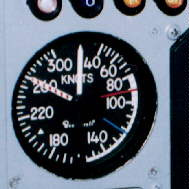 |
|||||
| Home | Research | For Teachers | HISTORY Level 1 Level 2 Level 3 |
PRINCIPLES Level 1 Level 2 Level 3 |
CAREER Level 1 Level 2 Level 3 |
| Gallery | Hot Links | What's New! | |||
| Web Administration and Tools | |||||
 |
|||||
| Home | Research | For Teachers | HISTORY Level 1 Level 2 Level 3 |
PRINCIPLES Level 1 Level 2 Level 3 |
CAREER Level 1 Level 2 Level 3 |
| Gallery | Hot Links | What's New! | |||
| Web Administration and Tools | |||||
![]()

The basic airspeed indicator on a Cessna 152 or an F-15E both read Indicated Airspeed
(IAS). This device measures the difference between STATIC pressure (usually from a sensor
not in the airstream) and IMPACT pressure (called the stagnation pressure
received from an aircraft's PITOT TUBE -- which is in the airstream). When the aircraft is
not moving, the pressures are equal (and the airspeed is zero). On takeoff, the on-rushing
air will result in a greater pressure in the PITOT TUBE and this difference in pressure
from the static sensor can be used to calculate the airspeed (in miles per hour (MPH) or
nautical miles per hours (KNOTS)) at which the aircraft is moving through the air.
The velocity is given by the square root of (2 x [stagnation pressure -
static pressure] / air density).
TYPES OF AIRSPEED
The airspeed indicator discussed above measures the aircraft's speed through the air. At
sea level, this speed is very close to the aircraft's TRUE AIRSPEED (TAS). TAS is the
actual airspeed of the aircraft through the air mass. As an aircraft climbs, the indicated
airspeed will decrease as the air becomes thinner and the impact pressure is reduced. For
example, at sea level a TAS of 440 MPH will equal an IAS of about 440. At 20,000 feet, a
TAS of 440 MPH will have an IAS of about 360. Thus, for a given TAS, indicated airspeed
will decrease with altitude.
TRUE AIRSPEED adjusts the IAS for the given temperature and pressure. The
F-15E receives TAS from the Air Data Computer which measures the outside temperature and
pressure.
GROUNDSPEED is another important airspeed to pilots. Groundspeed is the
aircraft's actual speed across the earth. It equals the TAS plus or minus the wind factor.
For example, if your TAS is 500 MPH and you have a direct (180 degrees from your heading)
tail-wind of 100 MPH, your groundspeed is 600 MPH. Groundspeed can be measured by onboard
Inertial Navigation Systems (INS) or by Global Positioning Satellite (GPS) receivers. One
"old-fashion" method is to record the time it takes to fly between two known
points. Then divide this time by the distance. For example, if the distance is 18 miles,
and it took an aircrew in an F-15E 2 minutes to fly between the points, then their
groundspeed is:
18 miles / 2 minutes = 9 miles per minute
This can be converted to miles per hour by multiplying by 60 (60 minutes in an hour)
9 miles per minute X 60 minutes per hour = 540 Miles per hour
This page is an enhanced version of the page found on the 90th Fighter Squadron website
Send all comments to ![]() aeromaster@eng.fiu.edu
aeromaster@eng.fiu.edu
© 1995-98 ALLSTAR Network. All rights reserved worldwide.
| Funded in part by | Used with permission From 90th Fighter Squadron "Dicemen" Aviation |
Updated: February 24, 1999